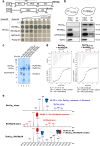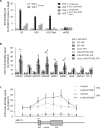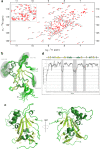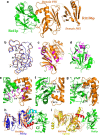The box C/D snoRNP assembly factor Bcd1 interacts with the histone chaperone Rtt106 and controls its transcription dependent activity
- PMID: 33767140
- PMCID: PMC7994586
- DOI: 10.1038/s41467-021-22077-4
The box C/D snoRNP assembly factor Bcd1 interacts with the histone chaperone Rtt106 and controls its transcription dependent activity
Abstract
Biogenesis of eukaryotic box C/D small nucleolar ribonucleoproteins initiates co-transcriptionally and requires the action of the assembly machinery including the Hsp90/R2TP complex, the Rsa1p:Hit1p heterodimer and the Bcd1 protein. We present genetic interactions between the Rsa1p-encoding gene and genes involved in chromatin organization including RTT106 that codes for the H3-H4 histone chaperone Rtt106p controlling H3K56ac deposition. We show that Bcd1p binds Rtt106p and controls its transcription-dependent recruitment by reducing its association with RNA polymerase II, modulating H3K56ac levels at gene body. We reveal the 3D structures of the free and Rtt106p-bound forms of Bcd1p using nuclear magnetic resonance and X-ray crystallography. The interaction is also studied by a combination of biophysical and proteomic techniques. Bcd1p interacts with a region that is distinct from the interaction interface between the histone chaperone and histone H3. Our results are evidence for a protein interaction interface for Rtt106p that controls its transcription-associated activity.
Conflict of interest statement
The authors declare no competing interests.
Figures







Similar articles
-
Structure/Function Analysis of Protein-Protein Interactions Developed by the Yeast Pih1 Platform Protein and Its Partners in Box C/D snoRNP Assembly.J Mol Biol. 2015 Aug 28;427(17):2816-39. doi: 10.1016/j.jmb.2015.07.012. Epub 2015 Jul 22. J Mol Biol. 2015. PMID: 26210662
-
A conserved Bcd1 interaction essential for box C/D snoRNP biogenesis.J Biol Chem. 2019 Nov 29;294(48):18360-18371. doi: 10.1074/jbc.RA119.010222. Epub 2019 Sep 19. J Biol Chem. 2019. PMID: 31537647 Free PMC article.
-
Protein Hit1, a novel box C/D snoRNP assembly factor, controls cellular concentration of the scaffolding protein Rsa1 by direct interaction.Nucleic Acids Res. 2014;42(16):10731-47. doi: 10.1093/nar/gku612. Epub 2014 Aug 28. Nucleic Acids Res. 2014. PMID: 25170085 Free PMC article.
-
The R2TP chaperone complex: its involvement in snoRNP assembly and tumorigenesis.Biomol Concepts. 2014 Dec;5(6):513-20. doi: 10.1515/bmc-2014-0028. Biomol Concepts. 2014. PMID: 25429602 Review.
-
The R2TP complex: discovery and functions.Biochim Biophys Acta. 2012 Jan;1823(1):101-7. doi: 10.1016/j.bbamcr.2011.08.016. Epub 2011 Sep 8. Biochim Biophys Acta. 2012. PMID: 21925213 Review.
Cited by
-
iSnoDi-LSGT: identifying snoRNA-disease associations based on local similarity constraints and global topological constraints.RNA. 2022 Dec;28(12):1558-1567. doi: 10.1261/rna.079325.122. Epub 2022 Oct 3. RNA. 2022. PMID: 36192132 Free PMC article.
-
Emerging Data on the Diversity of Molecular Mechanisms Involving C/D snoRNAs.Noncoding RNA. 2021 May 6;7(2):30. doi: 10.3390/ncrna7020030. Noncoding RNA. 2021. PMID: 34066559 Free PMC article. Review.
References
Publication types
MeSH terms
Substances
LinkOut - more resources
Full Text Sources
Other Literature Sources
Molecular Biology Databases

